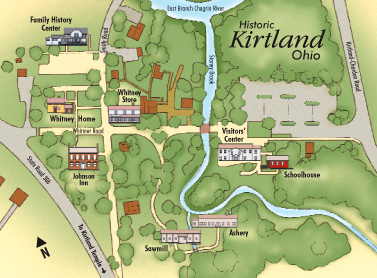“Kirtland Restored,” Ensign, Dec. 2003, 30
Kirtland Restored
Newly restored historic sites help us envision how the Church flourished and suffered here between 1831 and 1838.
Once again an ashery stands on Stoney Brook, just as it did when early Latter-day Saints settled in Kirtland. The ashery (background) is one of several buildings rebuilt by The Church of Jesus Christ of Latter-day Saints as part of the restoration of historic Kirtland, Ohio. The Prophet Joseph Smith (right) moved the newly organized Church from New York to Ohio in 1831.
The small home (far right) of early converts Newel K. and Elizabeth Ann Whitney had a summer kitchen on the back, a single bedroom on the main floor where Sister Whitney’s aunt frequently stayed, and an open half-story upstairs where Newel, Elizabeth Ann, and their children slept.
Started by Newel K. Whitney, the ashery (background) was essential to the entire community’s economic well-being. Townspeople turned their wood, field, and hearth ashes into a useful resource at the ashery. River water was used to leach lye from the ashes, which was then processed into potash (bottom inset) and sold for about U.S. $100 a barrel. Potash was an important ingredient in making items such as soap, glass, paper, gunpowder, and leather goods.
From 1833 to 1836, the focus of the Saints was the building of the Kirtland Temple (top inset), now owned by the Community of Christ. The Prophet’s brother Hyrum began the work by using a scythe to level the standing grain on the site while others took down the rails of a fence. Later, workers cut stone from a nearby quarry (center inset). Heavenly manifestations accompanied the temple dedication. On 3 April 1836, the Savior appeared in the temple to the Prophet Joseph Smith and Oliver Cowdery. Then Moses, Elias, and Elijah appeared and restored priesthood keys.

The above map shows historic Kirtland as it has been restored. The sawmill (background) was built by Latter-day Saints on Newel K. Whitney’s property but was a Church mill rather than a private operation. It provided the cash-poor Church a means of building the temple in the style dictated by the revelations. It also provided jobs for the many Latter-day Saints arriving in Kirtland. A waterwheel (top inset) powered the saw and lathe. Lumber from this mill was used for the temple and other buildings. The original sawmill burned down in the early 1850s.
The schoolhouse (center and bottom insets) was a center of activity. Schoolchildren played ball, a game called mumblety-peg, and marbles in the school yard. School supplies included a spelling book, a reader, an arithmetic book, and a slate. Students carved their own pencils from soapstone. On Sundays, the Saints often met in the schoolhouse for Church meetings.
Newel K. Whitney, with his general store (background and center inset) and ashery, was well established by February 1831 when the Prophet Joseph and Emma Smith arrived. The Whitneys generously made their resources available to the Church. While living in the store (top inset), the Prophet received many important revelations now recorded in the Doctrine and Covenants. And it was in an upper room of the store that the School of the Prophets met. Truly, in Kirtland the Lord helped the Prophet lay the foundation for the Church.
John Johnson operated an inn (bottom inset) near the Whitney store. Although they eventually left the Church, the Johnsons were early converts who had a significant impact for good.
Photography by Welden C. Andersen
Joseph Smith, by Alvin Gittins